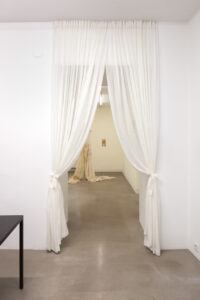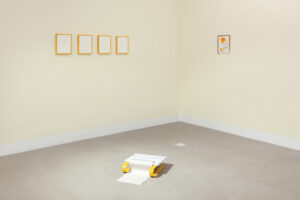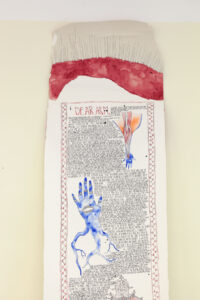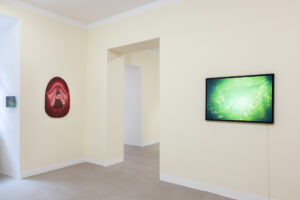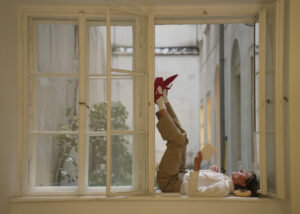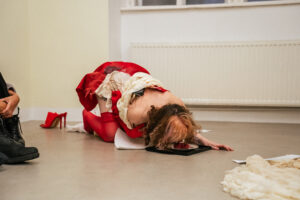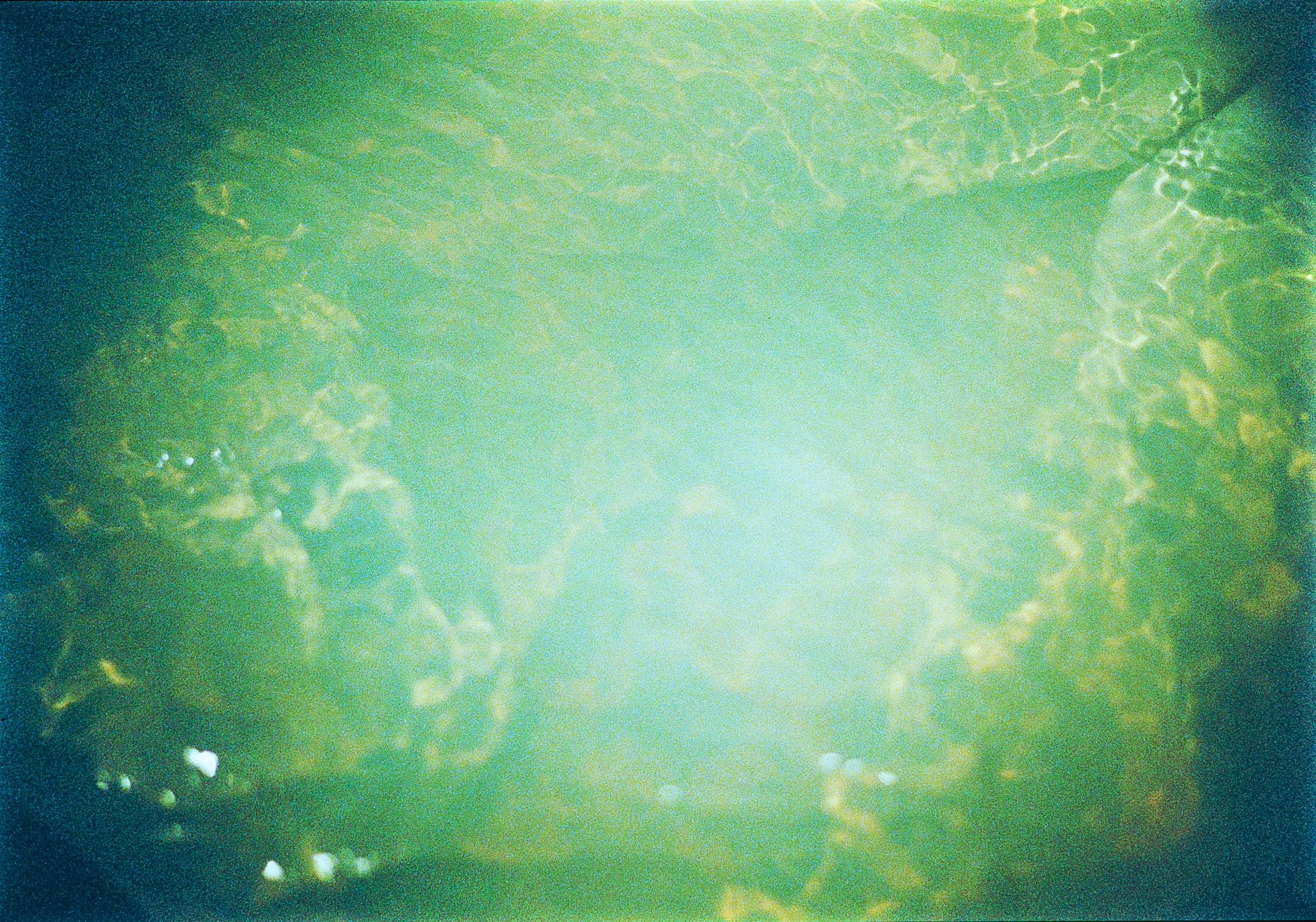
A Tragical Romance is an evocative exhibition exploring the transcendent potential of the human body through the works of artists Leah Clements, Rebecca Jagoe, Korallia Stergides and Marianne Vlaschits. Moving beyond the conventional boundaries of human form, these artists delve into non-human connections, embracing the natural and supernatural realms to create a narrative of unity and interconnectedness.
The exhibition challenges the able-bodied perspective, highlighting how desire, love, and intimacy can foster new forms of crip embodiment. The works presented in A Tragical Romance engage with elements such as water, rocks, ghosts, and animals, inviting viewers to consider an over-identification with the external world. This shift is articulated through various mediums, including photography, sculpture, painting and performance, with text serving as a central axis for this exploration.
The artworks reflect a profound sentimentality, addressing the fantasy of crossing the human/non-human divide and the grim reality of our toxic relationship with nature in the face of climate destruction. This exhibition draws parallels with the Romantic era, known for its intense emotions and fascination with the sublime. Like the Romantics, these contemporary works navigate the interplay between beauty and darkness, exploring themes of sorrow, loss, and the fragility of life. In doing so, they offer a contemplative reflection on mortality, particularly through the lens of illness and disability.
Between Flesh and Fantasy: Performances
Saturday, 14th September at 5.30pm
Low Roaming Cloud by Korallia Stergides is a meditative journey through the landscapes of mourning and sensorial memory. In a blend of poetry, performance, and song, Stergides weaves together personal loss with reflections on childhood, illness, and care, creating a space where the boundaries between human and animal, self and other, blur. This work challenges the distinctions between species and the material world, while also exploring the embodied experiences of illness. Stergides invites us to consider how memory and materiality intertwine, reflecting the delicate balance between presence and absence in a world where all beings are interconnected.
with your teeth by Rebecca Jagoe delves into the intense fear of change and the yearning for permanence in romantic obsession. Using metaphors of cannibalism and the unsettling mating rituals of deep-sea anglerfish, Jagoe examines how desire can slip into possessiveness, how the longing for love can become a desire to merge, to lose oneself in another. This performance questions the boundaries of individual identity and explores the dissolution of self into a larger, unchanging entity. It also contemplates the complexities of bodies, love, and the desire for a future free of pain and uncertainty.
Trigger Warning:
These performances contain intense themes of anxiety, loss, and desire for extreme closeness. It includes graphic descriptions of body invasion and fusion, sexual content, raw meat, blood and references to death and cannibalism. Viewer discretion is advised.
Existential Themes and Dissolution – Existential discussions about the self, stasis, and a desire to dissolve into the universe or the ocean.
Between Flesh and Fantasy: A Conversation on Bodies and Archives
Wednesday, 16th October at 6pm
As part of the group exhibition A Tragical Romance for Curated By, this conversation brings together artist Marianne Vlaschits, curator Mariana Lemos, and historian-theorist Lisa Moravec to explore the intersections of the body, archives, and the cosmos. Using Vlaschits’ paintings Celestial Mechanics and Glitch Music 2.0 as focal points, we will discuss how these works frame the body as an archive and the archive as a living body.
Celestial Mechanics draws inspiration from 16th-century scientific illustrations in the archives of the Institute for Astrophysics at the University of Vienna, transforming these historical images to blur the lines between the celestial and the human. Glitch Music 2.0 connects the stuttering rhythms of neutron stars with the elemental composition of our bodies, reflecting Vlaschits’ own experience of stuttering as an embodied archive, intertwining personal and cosmic narratives.
The discussion will also delve into how Vlaschits’ work resonates with the exhibition’s themes, particularly in exploring new perspectives on embodiment and the limits of human identity. We will consider how her art redefines the boundaries between the human and non-human, and examine how artistic practice itself can serve as a living archive of both personal and universal histories.
Exhibition text:
A Tragical Romance emerges from the gutted remnants of stories long buried, their wounds unhealed and unspoken. The works of Leah Clements, Rebecca Jagoe, Marianne Vlaschits, and Korallia Stergides create a landscape where bodies become myths, personal archives, and sites of transformation. Here, the aged word “tragical” recalls something feverish and expansive, where love and loss drift through centuries, their resonance never entirely fading. Time does not march forward but spills, seeps, and loops back into itself—waves of delay and return, where survival is not about endurance but dissolution, where transformation is inextricable from breakdown. In this liquid world, bodies soften, boundaries blur. Skin becomes porous, seeping, dissolving into something other, something not-quite-human. The artists take us into a space where the body, untethered, floats on a tide of time. Time made slow, sick, stretched and weird.
Leah Clements’ photographs unfold like dreams in water—nocturnal, shimmering. Light fractures on bathwater, as if other worlds were struggling to break through the surface. Bodies are only faint suggestions—vaginal, cavernous—never fully present, always dissolving into reflections, ripples, something not quite graspable. Her images are not landscapes to be entered but thresholds—portals to somewhere not yet known, created by the insomnia-riddled mind somewhere between seduction and fear.
Across this threshold, Marianne Vlaschits’ paintings pulse with cosmic resonance—bodies turned celestial, stars turned flesh. Portal opens like a throat, a galactical vast darkness or a wide-open mouth. What is alien becomes human; what is human becomes something larger, planetary. In the stuttering stars of Glitch Music 2.0, neutron bodies orbit toward inevitable collision, bound by forces they cannot escape. Their slow collapse becomes a romance—creation and destruction spiralling together in an embrace, echoing the tender but violent motion of our own collapsing world.
In Rebecca Jagoe’s work, the body becomes a leaky vessel—soft, wet, grotesque, consumed by desire. Scrofula I and Scrofula II speak of illness, of the strange and unsettling ways we romanticise frailty, and fetishize sickness. The consumptive body of the Victorians once eroticized in its fragility, now returns as something both mourned and celebrated. In Jagoe’s work, piss, blood, tears, and sweat are not markers of weakness but of transcendence, a surrender to the body’s inevitable meltdown. Garments hang ghost-like, emptied of their wearers or opened up wide, as though transformed into the stratosphere by deep time.
Korallia Stergides’ bright yellow medicine stains everything it touches with the mark of grief. It moves between bodies and artworks like a sunbeam pacing the time across the room. In Low Roaming Cloud, this liquid—shared between herself and her dog as a child—leaks into the text and drawings of Jagoe’s Of Thyrst, where they share a language that itself becomes fluid. Jagoe uses a fervid blend of Middle English and neologisms to layer complex emotions with history and tales. For Stergides memory and metaphor melt together: clouds, dogs, marble floors, all blurring into one another, time slipping through them like water through fingers until they disappear. The body, here, dissolves into a soft and sensorial world where distinctions between human and non-human are no longer fixed.
In with your teeth, Jagoe veers into obsession—romantic, monstrous, erotic. Desire becomes a form of consumption, a hunger to merge with the other, to lose oneself completely in love. But in the depths of longing, we come apart. Letters to Arm, a love letter to a blue plastic prosthetic, pushes desire to its limits, asking us to reckon with what we love and how we love, what we desire and what we consume. These tender obsessions unravel into the inanimate world, obscuring the line between body and object, human and other.
Throughout A Tragical Romance, bodies transform and dissolve—into stars, into stone, into one another. Time thickens, bends, and folds, reshaping itself in the sick body’s slow rhythms. There is no clear delineation, no straightforward narrative—only cycles of creation and destruction, collision and collapse. The tragedy here is not the end; it is the process. To transform is to surrender, to leak, to let go.
As in Vlaschits’ stars, the exhibition itself spins toward dissolution—an inevitable, necessary movement toward becoming something else. What remains in this landscape of soft edges and porous bodies is not strength but the possibility of change. It is through the breaking down, the permeation, and the dissolving that we continue, that we find new forms. In this world, love and loss are not separate; they are folded into the body, the earth, the stars—forever blurring, forever becoming.
“I am not one and simple, but complex and many. I can feel in myself innumerable forces—like a cloud full of rain; like a tree whose boughs have broken with the weight of their fruit.”
– The Waves, Virginia Woolf
Curated by
Mariana Lemos (b. 1991, Lisbon), is an independent curator based in London. Her practice focuses on performance art, affect, queer/feminist phenomenologies, and issues related to illness and disability. She holds an MFA in Curating from Goldsmiths University of London (2020) and a BA in Fine Arts (2015).
Her curatorial approach centres on public programming, accessibility, and feminist methodologies, often working collectively and collaboratively. Lemos is a member of the FDRG feminist reading group and the SALOON London board. She was Co-Editor at Mercurius Magazine and has written for Art Review, Flash Art, Mousse and Concreta. She has worked as the studio manager for artist Angela de La Cruz and in galleries such as Lisson Gallery, Union Pacific, Arcadia Missa, Black Tower, and the Feminist Library. Recent projects include ‘Vaivém’ by Francisca Pinto at Ostra, Lisbon (PT/2024); ‘DIG IN: Maisie Maris & Laura Mallows’ at Staffordshire St, London (UK/2023); ‘INSOMNIA’ by Leah Clements at South Kiosk, London (UK/2022-23); and ‘Oceanic Feelings’ at Electro Studios Space, St Leonards (UK/2021).

